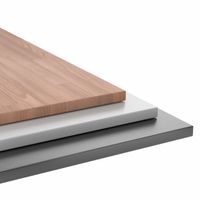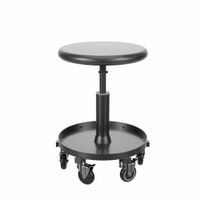Call +(254) 703 030 000 / 751 483 999 / 721 704 777
- Home
- Material Handling
- Storage Workspace
- Workbenches Shop Furniture
.....Read More
Frequently Asked Questions
What are the best materials for a durable workbench?
The best materials for a durable workbench include:
1. **Solid Wood**: Hardwoods like maple, oak, and beech are excellent choices due to their strength and durability. They can withstand heavy use and are resistant to dents and scratches. Softwoods like pine are more affordable but less durable.
2. **Plywood**: High-quality plywood, especially marine-grade or Baltic birch, offers a strong and stable surface. It resists warping and is less expensive than solid wood, making it a practical choice for many.
3. **MDF (Medium-Density Fiberboard)**: MDF is smooth and flat, ideal for precision work. It’s affordable and easy to work with, though it’s less durable than solid wood and can be susceptible to moisture damage.
4. **Steel**: Steel workbenches are incredibly durable and can support heavy loads. They are ideal for industrial settings and environments where the bench will be exposed to chemicals or heavy impacts.
5. **Stainless Steel**: Offers the same benefits as regular steel but with added corrosion resistance. It’s perfect for environments where hygiene is crucial, such as food preparation areas.
6. **Laminate**: A laminate surface over a wood or MDF core provides a smooth, easy-to-clean surface. It’s resistant to stains and scratches, making it suitable for light to medium-duty tasks.
7. **Concrete**: For extreme durability, concrete workbenches are virtually indestructible. They are ideal for heavy-duty applications but are heavy and difficult to move.
8. **Plastic or Resin**: High-density polyethylene or resin workbenches are lightweight, resistant to chemicals, and suitable for outdoor use. They are less durable than metal or wood but offer good resistance to moisture and corrosion.
Choosing the right material depends on the intended use, budget, and environmental conditions.
How do I choose the right size workbench for my workshop?
To choose the right size workbench for your workshop, consider the following factors:
1. **Space Availability**: Measure the dimensions of your workshop. Ensure the workbench fits comfortably, allowing for movement and access to tools and materials. Leave space for other equipment and storage.
2. **Purpose and Use**: Determine the primary tasks you'll perform. For detailed work, a smaller bench may suffice, while larger projects require more surface area. Consider if you need space for tools, materials, or additional equipment.
3. **Workbench Dimensions**: Standard workbenches are typically 28-36 inches high, 48-96 inches wide, and 24-36 inches deep. Choose dimensions that suit your tasks and ergonomic needs.
4. **Ergonomics**: Ensure the height is comfortable for your stature to prevent strain. Adjustable-height workbenches offer flexibility for different tasks and users.
5. **Material and Durability**: Select a workbench made from materials that suit your work type. Heavy-duty tasks may require a metal or hardwood bench, while lighter tasks can use plywood or MDF.
6. **Storage Needs**: Consider built-in storage options like drawers or shelves for tools and materials. This can influence the size and design of the workbench.
7. **Mobility**: If you need to move the workbench, consider a model with wheels. Ensure it has locking mechanisms for stability during use.
8. **Budget**: Determine your budget, balancing size, quality, and features. Larger, more durable workbenches typically cost more.
9. **Future Needs**: Anticipate future projects or expansions. Choose a workbench that can adapt to changing needs.
By evaluating these factors, you can select a workbench that optimizes your workspace, enhances productivity, and suits your specific requirements.
What are the benefits of a modular workbench system?
A modular workbench system offers several benefits that enhance efficiency, flexibility, and productivity in various work environments.
1. **Customization**: Modular workbenches can be tailored to meet specific needs. Components such as shelves, drawers, and tool racks can be added or removed, allowing users to create a workspace that suits their tasks and preferences.
2. **Flexibility**: These systems can be easily reconfigured or expanded as requirements change. This adaptability is particularly beneficial in dynamic work environments where tasks and processes evolve over time.
3. **Space Optimization**: Modular workbenches help maximize available space. By allowing for vertical and horizontal expansion, they enable efficient use of floor space, which is crucial in smaller workshops or crowded industrial settings.
4. **Improved Organization**: With customizable storage options, modular workbenches facilitate better organization of tools and materials. This leads to reduced clutter, easier access to necessary items, and a more streamlined workflow.
5. **Enhanced Productivity**: By providing a well-organized and adaptable workspace, modular workbenches can significantly boost productivity. Workers spend less time searching for tools and more time focusing on their tasks.
6. **Durability and Quality**: Many modular workbench systems are built with high-quality materials designed to withstand heavy use. This durability ensures a long lifespan, providing a good return on investment.
7. **Ergonomics**: Adjustable components allow users to set up their workbenches at optimal heights and configurations, reducing strain and improving comfort during prolonged use.
8. **Cost-Effectiveness**: While the initial investment might be higher, the long-term benefits of adaptability, durability, and improved efficiency can lead to cost savings over time.
9. **Aesthetic Appeal**: A well-organized and customizable workbench can enhance the overall appearance of a workspace, contributing to a professional and tidy environment.
How can I improve the ergonomics of my workbench setup?
To improve the ergonomics of your workbench setup, start by adjusting the height of the workbench to match your standing or sitting height, ensuring your elbows are at a 90-degree angle when working. Use an adjustable chair with lumbar support if sitting, and consider an anti-fatigue mat if standing. Organize tools and materials within easy reach to minimize excessive stretching or bending.
Ensure adequate lighting to reduce eye strain, using adjustable lamps for focused tasks. Position frequently used tools and equipment at waist height to avoid repetitive reaching. Use tool holders or pegboards to keep tools organized and accessible.
Incorporate a footrest to shift weight and reduce fatigue if standing for long periods. Use cushioned floor mats to reduce pressure on joints. Arrange your workspace to allow for natural movement, avoiding awkward postures.
Consider using ergonomic tools with padded grips to reduce hand strain. Implement a monitor stand or adjustable arm for screens, keeping the top of the screen at or slightly below eye level.
Take regular breaks to stretch and move, reducing the risk of repetitive strain injuries. Use a timer to remind yourself to change positions or take breaks.
Lastly, personalize your setup to fit your specific tasks and body dimensions, ensuring comfort and efficiency. Regularly assess and adjust your setup as needed to maintain optimal ergonomics.
What are the essential features to look for in a workbench?
When selecting a workbench, consider the following essential features:
1. **Durability and Material**: Choose a workbench made from high-quality materials like hardwood, steel, or heavy-duty plastic to ensure longevity and withstand heavy use.
2. **Size and Space**: Ensure the workbench fits your workspace and provides ample surface area for your projects. Consider the height for ergonomic comfort.
3. **Weight Capacity**: Check the maximum weight the workbench can support, especially if you plan to work with heavy tools or materials.
4. **Stability**: Look for a workbench with a sturdy frame and non-slip feet to prevent wobbling during use.
5. **Storage Options**: Integrated drawers, shelves, or pegboards can help organize tools and materials, keeping your workspace tidy and efficient.
6. **Portability**: If you need to move the workbench frequently, consider one with wheels or a foldable design for easy transport and storage.
7. **Surface Material**: The work surface should be durable and appropriate for your tasks. Options include wood, metal, or laminate, each offering different benefits.
8. **Vise Compatibility**: Ensure the workbench can accommodate a vise if your projects require clamping.
9. **Electrical Outlets**: Built-in power strips or outlets can be convenient for powering tools and reducing cord clutter.
10. **Customization**: Some workbenches offer modular designs or adjustable features, allowing you to tailor the setup to your specific needs.
11. **Assembly and Maintenance**: Consider the ease of assembly and maintenance requirements to ensure long-term usability.
12. **Cost**: Balance your budget with the features you need, ensuring you get the best value without compromising on essential qualities.
By focusing on these features, you can select a workbench that enhances productivity and suits your specific work requirements.
How do I maintain and care for my workbench?
To maintain and care for your workbench, start by keeping it clean. After each use, remove dust, debris, and any leftover materials using a brush or vacuum. Wipe the surface with a damp cloth to remove any stains or spills, and ensure it is dry to prevent moisture damage.
Regularly inspect your workbench for any signs of wear or damage. Tighten loose screws or bolts and replace any damaged parts, such as vises or clamps. If your workbench has a wooden surface, periodically sand it lightly to remove scratches and apply a protective finish like oil, wax, or polyurethane to prevent moisture absorption and enhance durability.
Organize tools and materials to prevent clutter. Use pegboards, shelves, or drawers to store tools and supplies, ensuring they are easily accessible and reducing the risk of accidents. Label storage areas to maintain order and efficiency.
Check the stability of your workbench. Ensure it is level and adjust the legs or add shims if necessary. A stable workbench enhances safety and precision in your projects.
For metal workbenches, apply a rust inhibitor or light oil to prevent corrosion. Regularly check for rust and address it promptly with a rust remover or sandpaper.
If your workbench is mobile, inspect the casters or wheels for wear and ensure they lock securely to prevent unwanted movement during use.
Finally, establish a routine maintenance schedule. Regular care and attention will extend the life of your workbench, ensuring it remains a reliable and safe workspace for your projects.
What are the differences between preconfigured and configurable workbenches?
Preconfigured workbenches are ready-to-use setups that come with a fixed set of tools, features, and layouts designed for specific tasks or industries. They are designed to provide a quick and efficient solution for users who need to start working immediately without spending time on customization. These workbenches are ideal for environments where tasks are repetitive and standardized, as they ensure consistency and reduce setup time. However, they offer limited flexibility, as users cannot modify the setup to suit individual preferences or unique project requirements.
Configurable workbenches, on the other hand, offer a high degree of customization, allowing users to tailor the setup according to their specific needs and preferences. These workbenches can be adjusted in terms of height, layout, and the types of tools and features included. This flexibility makes them suitable for environments where tasks vary significantly or where users have specific ergonomic or functional requirements. Configurable workbenches can adapt to different workflows, making them ideal for dynamic work environments. However, they may require more time and effort to set up initially, as users need to determine the optimal configuration for their needs.
In summary, the main difference lies in flexibility and customization: preconfigured workbenches offer a fixed, ready-to-use solution with limited adaptability, while configurable workbenches provide a customizable setup that can be tailored to individual needs and changing tasks.












